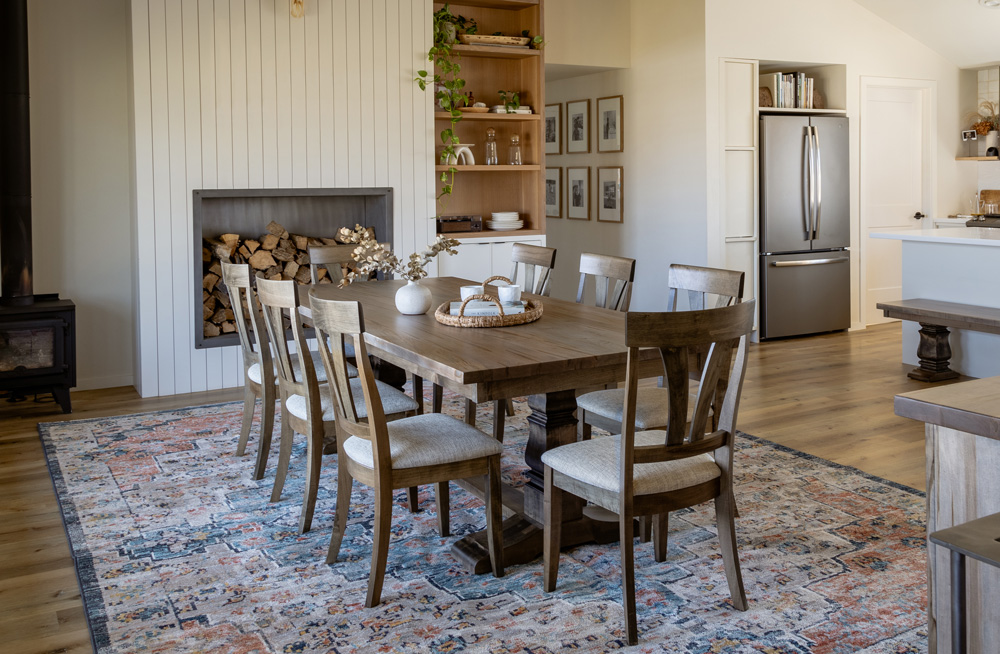When it comes to furnishing your California home, selecting the perfect dining table is a crucial decision. The dining table serves as a focal point in the dining area, bringing family and friends together for meals and special occasions. It also plays a significant role in enhancing the overall aesthetic and functionality of your home. This blog post will guide you through the process of selecting a dining table, considering various factors that are essential for making an informed decision.
The Importance of a Dining Table
A dining table is not just a piece of furniture; it is a gathering place where memories are made, stories are shared, and connections are strengthened. It is where you enjoy delicious meals, engage in conversations, and create a warm and inviting atmosphere. The dining room table serves as the centerpiece of your dining space, setting the tone for the overall style and ambiance of the room.
Factors to Consider
Before diving into the details, let’s explore some key factors you should consider when selecting a dining table for your California home:
- Available space: Measure the dimensions of your dining room to determine the size of the table that will fit comfortably.
- Number of people: Consider the average number of people you usually entertain to ensure there is enough seating for everyone.
- Shape and proportions: Decide whether a rectangular, round, square, or oval table would best suit your space and aesthetic preferences.
- Design and style: Choose a table that complements the overall style and decor of your home, whether it’s modern, traditional, rustic, or coastal
Determining the Perfect Size

The size of your dining table is a crucial aspect to consider, as it should comfortably accommodate both the available space and the number of people you intend to seat. Following are considerations for determining the perfect size.
1. Available Space
Start by measuring the dimensions of your dining area, including the length, width, and height. Leave enough room for people to move around comfortably without feeling cramped. As a general rule, there should be at least 36 inches of clearance between the table and the surrounding walls or furniture.
2. Number of People
Consider the average number of people you expect to seat at the dining table. If you frequently entertain guests or have a large family, opt for a table with additional seating capacity. A good guideline is to allow approximately 24 inches of table width per person, ensuring everyone has enough elbow room.
3. Shape and Proportions
The shape of the dining table can significantly impact the overall aesthetics and functionality of the space. Here are some considerations for different table shapes:
- Rectangular tables: Ideal for larger dining areas, rectangular dining tables provide ample surface area for food and place settings. They are versatile and can accommodate more guests compared to other shapes.
- Round tables: Perfect for smaller spaces, round dining tables promote better conversation flow as everyone can see and hear each other. They are also great for families with young children, as there are no sharp corners to worry about.
- Square tables: Well-suited for compact dining areas or as an extension to a larger table, square tables create an intimate and cozy atmosphere. They work best for smaller groups or as a secondary dining space.
- Oval tables: A fusion of the rectangular and round shapes, oval dining tables offer a balance between elegance and flexibility. They are a great choice for both large and small dining areas.
Design and Style

Consider the design and style of the dining table to ensure it complements your home’s overall aesthetic. Here are some popular design styles:
- Modern and Contemporary Styles: Straight lines, minimalistic designs, and sleek finishes characterize modern and contemporary dining tables. Modern styles often feature materials like glass, metal, and polished wood for a sophisticated look.
- Traditional and Classic Styles: Traditional dining tables exude elegance and timelessness. They typically feature ornate details, intricate carvings, and rich wood finishes. Classic styles offer a sense of warmth and familiarity, creating a cozy atmosphere.
- Rustic and Farmhouse Styles: Rustic and farmhouse dining tables embrace a more casual and charming aesthetic. They often incorporate natural materials like reclaimed wood, distressed finishes, and sturdy construction.
- Coastal and Beach Styles: For a relaxed and coastal vibe, consider dining tables with light-colored finishes, natural textures, and breezy designs. Coastal styles evoke a sense of seaside living, bringing a touch of tranquility to your dining space.
Materials and Construction
The materials and construction of your dining table play a vital role in its durability, aesthetics, and maintenance. Here are some popular choices to consider:
1. Wood
Wood is a timeless and versatile material for dining tables. It offers warmth, durability, and a wide range of design possibilities. Some common types of natural wood used for dining tables include oak, walnut, mahogany, cherry and pine. Each wood type has its unique characteristics, grain patterns, and finishes, allowing you to choose one that aligns with your style preferences.
2. Glass
Glass dining tables are an excellent choice for those seeking a modern and contemporary look. They create an illusion of space, making the dining area appear more open and airy. Glass tables are available in various thicknesses and finishes, including clear, frosted, and tinted glass. However, it’s essential to consider the maintenance and potential for fingerprints or scratches with glass surfaces.
3. Metal
Metal dining tables offer an industrial and sleek aesthetic. They are typically constructed using materials like stainless steel, aluminum, or wrought iron. Metal tables can be paired with different tabletop materials, such as glass or wood, creating a striking contrast. They are known for their durability and resistance to wear and tear.
4. Composite Materials
If you’re looking for budget-friendly options or tables that are resistant to moisture and heat, consider dining tables made from composite materials. Examples of different materials include MDF (medium-density fiberboard), laminate, or engineered wood. These materials offer a wide range of styles and finishes, providing affordability and versatility.
Matching the Dining Table to Your Home’s Aesthetic
When selecting a dining table, it’s crucial to choose the best option that aligns with your home’s overall aesthetic. Let’s explore different styles and how they can be incorporated into your dining space:
1. Modern and Contemporary Styles
For a modern or contemporary home, opt for a dining table with clean lines, sleek finishes, and minimalist designs. Consider table top materials like glass, metal, or polished wood with smooth surfaces. Pair the table with modern dining chairs featuring ergonomic designs and upholstered seats for added comfort.
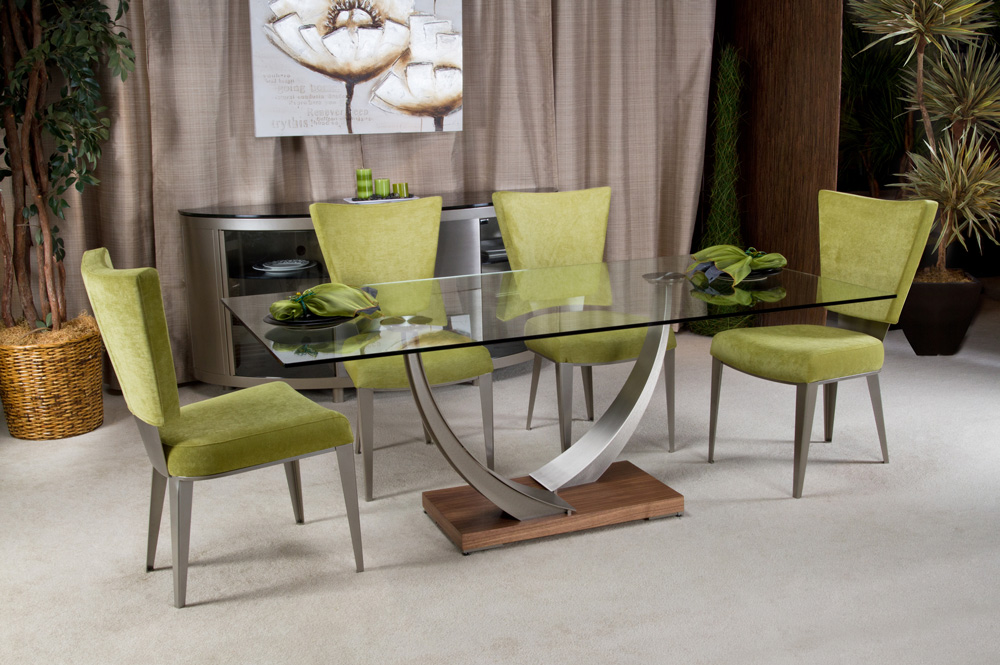
2. Traditional and Classic Styles
If your home boasts a traditional or classic design, choose a dining table that showcases elegance, craftsmanship, and intricate details. Look for tables with ornate carvings, pedestal bases, and rich wood finishes. Complete the look with upholstered dining chairs featuring traditional patterns or luxurious fabrics.
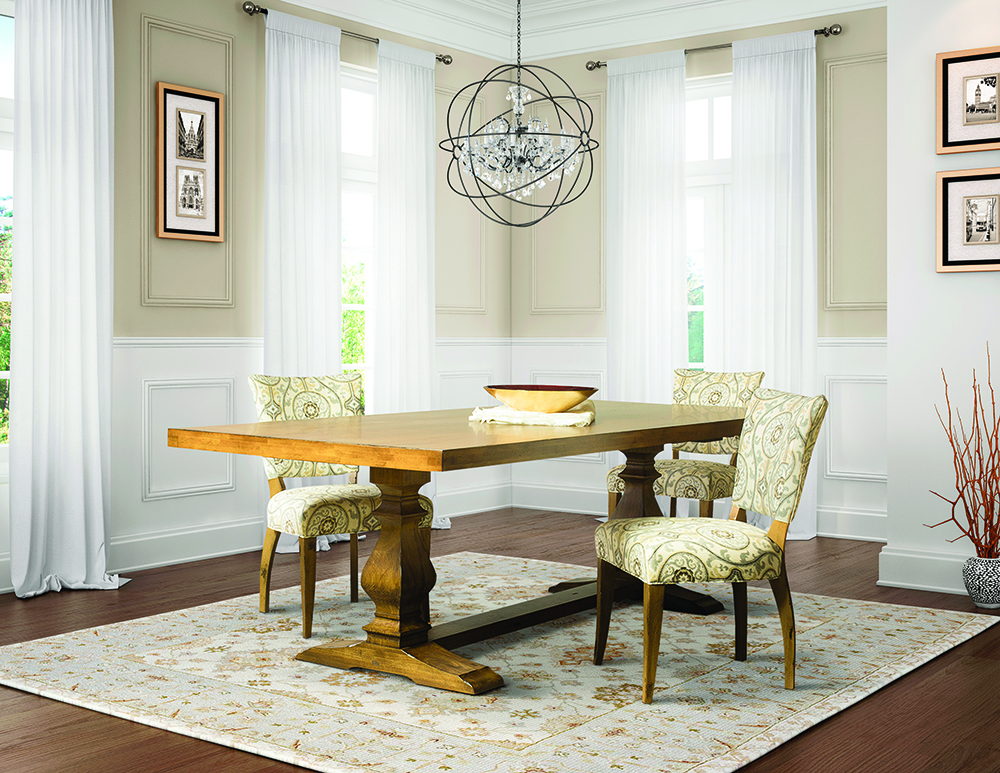
3. Rustic and Farmhouse Styles
For a cozy and inviting atmosphere, consider a dining table with a rustic or farmhouse style. Look for tables made from reclaimed wood, featuring distressed finishes, and sturdy construction. Pair the table with simple and sturdy chairs, opting for upholstered seats for added comfort.

4. Coastal and Beach Styles
If you’re aiming for a relaxed beach vibe, choose a dining table that exudes coastal charm. Look for light-colored finishes, natural textures, and breezy designs. Consider tables with rattan, bamboo, or whitewashed wood. Pair the table with chairs featuring woven or cane backs for an authentic coastal look.
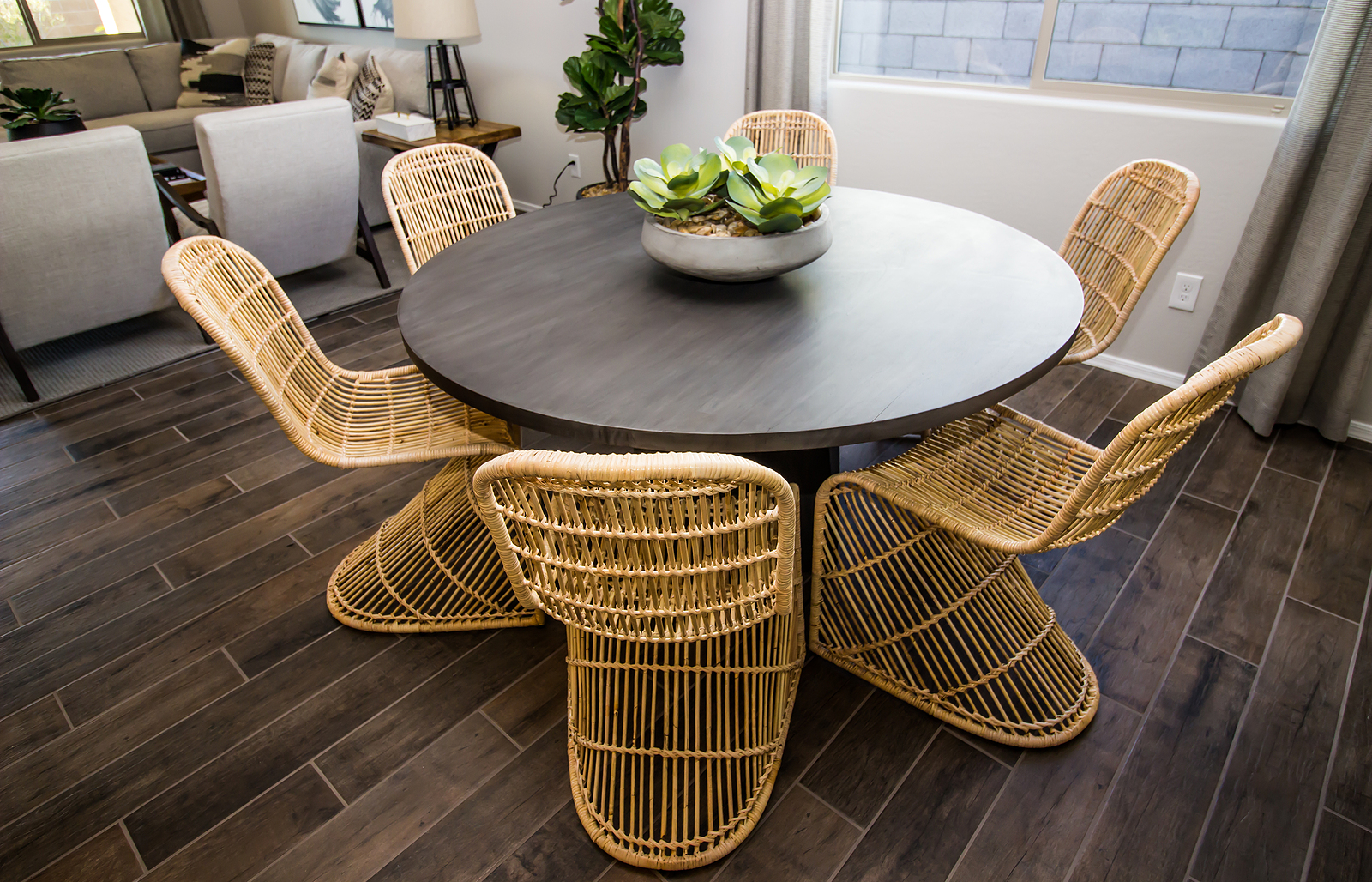
Practical Considerations for Everyday Use
Aside from the aesthetics, it’s essential to consider practical factors for everyday use when selecting a dining table. Let’s explore some crucial considerations:
1. Maintenance and Durability
Consider the level of maintenance required for the dining table material you choose. Some materials may require regular polishing, conditioning, or protective coatings. Additionally, opt for a table that is durable and built to withstand daily use. Solid wood tables or tables with high-quality veneers are often more resilient and long-lasting.
2. Stain and Scratch Resistance
If you anticipate spills or have young children or pets, consider a dining table that offers stain and scratch resistance. Some materials, such as laminate or composite surfaces, are more resistant to stains and scratches. You can also opt for tables with protective coatings or finishes that make cleaning up spills easier.
3. Extending and Folding Options
If you occasionally host large gatherings or need flexibility in your dining space, consider tables with extending or folding options. Extension mechanisms like a removable leaf allow you to increase the table’s length when needed, accommodating additional guests. Folding tables are ideal for compact spaces or as temporary dining solutions that can be conveniently stored away when not in use.
4. Comfort and Ergonomics
Ensure that the dining table and chairs provide comfort and proper ergonomics for extended periods of sitting. Chairs with supportive backrests and cushioned seats offer enhanced comfort during meals and conversations. It’s also important to consider the seat height in relation to the table height to ensure a comfortable dining experience.
Budgeting for Your Dining Table
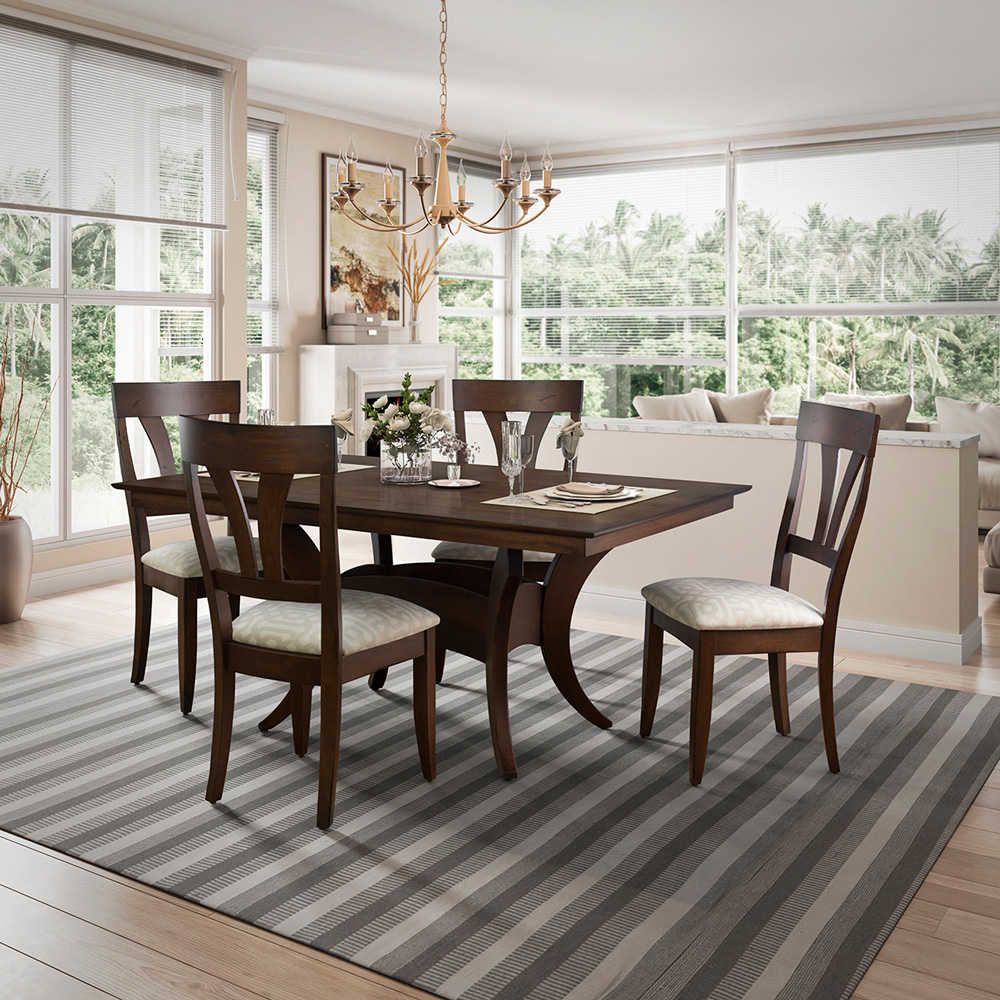
Establishing a budget range for your dining table purchase is essential to ensure you find an option that meets your needs without breaking the bank. Here are some considerations for budgeting:
1. Establishing a Budget Range
Before you start shopping, determine a budget range that aligns with your financial situation. Consider how much you are willing to invest in a dining table and set realistic expectations accordingly. Research the average prices for dining tables in different styles and materials to have a ballpark figure in mind.
2. Value for Money
While budget is important, it’s equally crucial to consider the value for money. Sometimes spending a bit more upfront can save you money in the long run if you invest in a high-quality, durable table that will last for years. Look for tables with solid construction, quality materials, and good customer reviews.
3. Financing Options
If you have a strict budget but desire a higher-priced dining table, explore financing options that may be available. Some furniture retailers offer installment plans, financing options, or promotional discounts that can make the purchase more manageable. However, ensure that you understand the terms, interest rates, and repayment plans before committing to any financing options.
4. Secondhand or Vintage Tables
Another budget-friendly option is to consider secondhand or vintage dining tables. Thrift stores, online marketplaces, and antique shops can be treasure troves for unique and affordable dining tables. With a little patience and some refinishing, you can find a one-of-a-kind table that adds character to your dining space.
Shopping Tips and Recommendations
Now that you have a good understanding of the factors to consider when selecting a dining table, let’s explore some shopping tips and recommendations to guide you in the process:
Research and Gather Inspiration
Before making a purchase, conduct thorough research and gather inspiration from various sources. Explore interior design magazines, websites, and social media platforms to discover different styles, materials, and designs that resonate with your taste. Save images or create a mood board to visualize how the dining table will fit into your overall home decor.
Visit Our Two Bay Area Showrooms
To get a hands-on experience and better assess the quality and craftsmanship of dining tables, visit California Dining & Barstools showrooms in Pleasant Hill and Sunnyvale. Browse our vast collection of dining room furniture, feel the materials, and sit at the tables to evaluate their comfort. Our knowledgeable furniture store staff can provide insights and recommendations based on your preferences and requirements to help you make the perfect choice.
FAQs
Q1: How much space should I allocate between the dining table and other furniture or walls?
It’s recommended to leave at least 36 inches of clearance between the dining table and surrounding walls or furniture. This ensures sufficient space for movement and allows chairs to be pulled out comfortably.
Q2: Can I mix different chair styles with my dining table?
Absolutely! Mixing different chair styles can add visual interest and create a unique, eclectic look. Just ensure that the chairs coordinate well in terms of height and overall aesthetics.
Q3: How do I maintain a wood dining table?
To maintain a wood dining table, dust it regularly with a soft cloth and avoid placing hot or wet items directly on the surface. Use a mild wood cleaner and polish periodically to keep the wood nourished and protected.
Q4: Are glass dining tables safe?
Glass dining tables can be safe as long as they are made with tempered glass, which is designed to be stronger and shatter-resistant. Tempered glass undergoes a special heat treatment process to enhance its durability and safety.
Q5: Can I extend my dining table to accommodate more guests?
Yes, many dining tables come with extension mechanisms that allow you to increase the length of the table when needed. This is a convenient option for accommodating additional guests during special occasions or gatherings.
